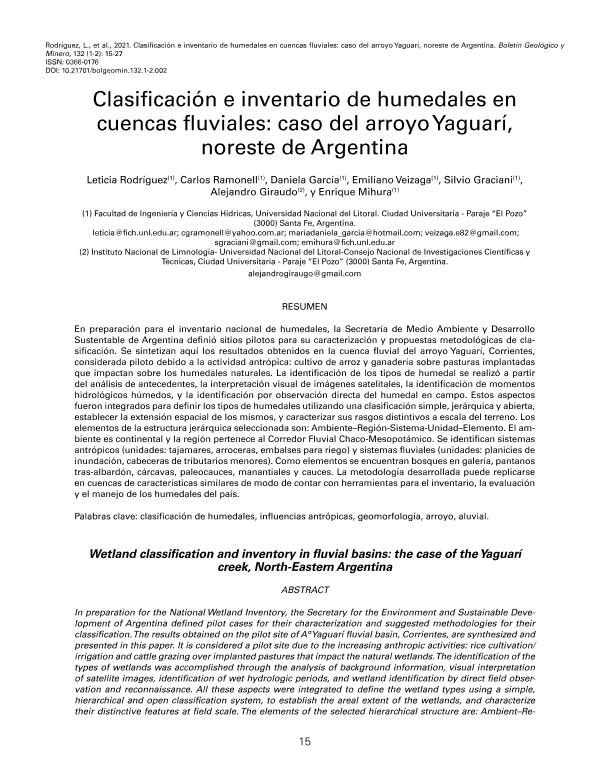Artículo
In preparation for the National Wetland Inventory, the Secretary for the Environment and Sustainable Development of Argentina defined pilot cases for their characterization and suggested methodologies for their classification. The results obtained on the pilot site of A° Yaguarí fluvial basin, Corrientes, are synthesized and presented in this paper. It is considered a pilot site due to the increasing anthropic activities: rice cultivation/ irrigation and cattle grazing over implanted pastures that impact the natural wetlands. The identification of the types of wetlands was accomplished through the analysis of background information, visual interpretation of satellite images, identification of wet hydrologic periods, and wetland identification by direct field observation and reconnaissance. All these aspects were integrated to define the wetland types using a simple, hierarchical and open classification system, to establish the areal extent of the wetlands, and characterize their distinctive features at field scale. The elements of the selected hierarchical structure are: Ambient–Re-gion-System-Unit–Element. The ambient is continental, and the region belongs to Chaco-Mesopotamic Fluvial Corridor. Anthropogenic systems (units: ponds, rice fields, irrigation water reservoirs), and fluvial systems (units: floodplains, minor tributaries headwaters) are identified. The elements that can be found are: riparian forests, marshes behind river banks, ditches, paleo-channels, springs and riverbeds. The developed methodology can be replicated in similar basins using these tools for the inventory, evaluation and management of Argentinean wetlands. En preparación para el inventario nacional de humedales, la Secretaría de Medio Ambiente y Desarrollo Sustentable de Argentina definió sitios pilotos para su caracterización y propuestas metodológicas de clasificación. Se sintetizan aquí los resultados obtenidos en la cuenca fluvial del arroyo Yaguarí, Corrientes, considerada piloto debido a la actividad antrópica: cultivo de arroz y ganadería sobre pasturas implantadas que impactan sobre los humedales naturales. La identificación de los tipos de humedal se realizó a partir del análisis de antecedentes, la interpretación visual de imágenes satelitales, la identificación de momentos hidrológicos húmedos, y la identificación por observación directa del humedal en campo. Estos aspectos fueron integrados para definir los tipos de humedales utilizando una clasificación simple, jerárquica y abierta, establecer la extensión espacial de los mismos, y caracterizar sus rasgos distintivos a escala del terreno. Los elementos de la estructura jerárquica seleccionada son: Ambiente–Región-Sistema-Unidad–Elemento. El ambiente es continental y la región pertenece al Corredor Fluvial Chaco-Mesopotámico. Se identifican sistemas antrópicos (unidades: tajamares, arroceras, embalses para riego) y sistemas fluviales (unidades: planicies de inundación, cabeceras de tributarios menores). Como elementos se encuentran bosques en galería, pantanos tras-albardón, cárcavas, paleocauces, manantiales y cauces. La metodología desarrollada puede replicarse en cuencas de características similares de modo de contar con herramientas para el inventario, la evaluación y el manejo de los humedales del país.
Clasificación e inventario de humedales en cuencas fluviales: Caso del arroyo yaguarí, noreste de Argentina
Título:
Wetland classification and inventory in fluvial basins: the case of the Yaguarí
creek, North-Eastern Argentina
Rodríguez, Leticia; Ramonell, Carlos Guillermo ; García, Daniela; Veizaga, Emiliano Andrés
; García, Daniela; Veizaga, Emiliano Andrés ; Graciani, Silvio Daniel; Giraudo, Alejandro Raul
; Graciani, Silvio Daniel; Giraudo, Alejandro Raul ; Mihura, Enrique
; Mihura, Enrique
 ; García, Daniela; Veizaga, Emiliano Andrés
; García, Daniela; Veizaga, Emiliano Andrés ; Graciani, Silvio Daniel; Giraudo, Alejandro Raul
; Graciani, Silvio Daniel; Giraudo, Alejandro Raul ; Mihura, Enrique
; Mihura, Enrique
Fecha de publicación:
01/2021
Editorial:
Instituto Geologico y Minero de Espana
Revista:
Boletín Geológico y Minero
ISSN:
0366-0176
Idioma:
Español
Tipo de recurso:
Artículo publicado
Clasificación temática:
Resumen
Palabras clave:
ALLUVIAL
,
ANTHROPOGENIC IMPACT
,
CREEK
,
GEOMORPHOLOGY
,
WETLAND CLASSIFICATION
Archivos asociados
Licencia
Identificadores
Colecciones
Articulos(CCT - SANTA FE)
Articulos de CTRO.CIENTIFICO TECNOL.CONICET - SANTA FE
Articulos de CTRO.CIENTIFICO TECNOL.CONICET - SANTA FE
Citación
Rodríguez, Leticia; Ramonell, Carlos Guillermo; García, Daniela; Veizaga, Emiliano Andrés; Graciani, Silvio Daniel; et al.; Clasificación e inventario de humedales en cuencas fluviales: Caso del arroyo yaguarí, noreste de Argentina; Instituto Geologico y Minero de Espana; Boletín Geológico y Minero; 132; 1-2; 1-2021; 15-27
Compartir
Altmétricas



